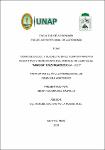Dosis de biosol y su efecto en el comportamiento vegetativo y rendimiento del forraje de Erythrina sp. “amasisa” en Zungarococha - 2021
Abstract
Biofertilizers in their indistinct forms are currently gaining importance for the management of solid waste from the field. The Faculty of Agronomy has been promoting the production of biofertilizers as an alternative fertilizer for agricultural use and for this reason the research work called BIOSOL FERTILIZER AND ITS EFFECT ON AGRONOMIC CHARACTERISTICS AND FORAGE YIELD Erythrina sp. "AMASISA" IN ZUNGAROCOCHA - 2021. This work has a completely randomized block design (D.B.C.A) with four treatments and four blocks with the following treatments T0 (sister biosol), T1 (1 ton biosol/ha), T2 (2 ton biosol/ha and T3 (3 ton biosol/ha) biosol/ha).ha) the following was reflected: That as the dose of biosol increases, the yields of the determined variables improve. With the T3 treatment (3 tons/ha) an average of 1.56 meters in plant height, 1.91 kilos of green matter/m2, dry matter of 0.40 kilos/m2 and yield of green matter per hectare of 19,100 kilos were achieved. With the T3 treatment (3 tons/ha) for a coverage percentage of 93.5% and a Leaves:Stem ratio of 2.38, the present work will be a contribution to the academy and farmers in the region. Los biofertilizantes en sus indistintas formas en la actualidad están tomando importancia para el manejo de los residuos sólidos del campo. La facultad de agronomía viene promoviendo la producción de biofertilizantes como alternativa de fertilizante para el uso agrícola y por tal sentido se está realizando el trabajo de investigación denominado DOSIS DE BIOSOL Y SU EFECTO EN EL COMPORTAMIENTO VEGETATIVO Y RENDIMIENTO DEL FORRAJE DE Erythrina sp. “AMASISA” EN ZUNGAROCOCHA – 2021. Este trabajo tiene un diseño de bloques completamente al azar (D.B.C.A) con cuatro tratamientos y cuatro bloques con los siguientes tratamientos T0 (biosol hermano), T1 (1 ton biosol/ha), T2 (2 ton biosol/ha y T3 (3 ton biosol/ha) biosol/ha).ha) se plasmó lo siguiente: Que a medida que se incrementa las dosis de biosol mejora los rendimientos de las variables determinadas. Con el tratamiento T3 (3 toneladas/ha) se logró un promedio de 1.56 metros en altura de planta, 1.91 kilos de materia verde /m2, de materia seca de 0.40 kilos/m2 y rendimiento de materia verde por hectárea de 19,100 kilos. Con el tratamiento T3 (3 toneladas/ha) para el porcentaje de cobertura de 93.5% y relación Hojas:Tallo 2.38. El presente trabajo será un aporte a la academia y ganaderos de la región.
Collections
- Tesis [675]


